Timeline of the United Kingdom home front during World War II

This is a Timeline of the United Kingdom home front during World War II (1939–45). For narrative and bibliography see Home front during World War II#Britain[1]
1939
3 June 1939
- The Military Training Act, Britain's first peacetime draft, comes into force. All men aged 20-21 are now liable to call-up for four years military service as 'Militiamen'.
24 August 1939
- Given the worsening situation in Europe, Parliament is recalled and immediately enacts the Emergency Powers (Defence) Act 1939, granting the government special legislative powers for the duration of the crisis.
- Army reservists are called up.
- Civil Defence workers are put on alert.
25 August 1939
- The National Defence Companies (a voluntary reserve force of former servicemen) are sand mobilised to protect "vulnerable points".[2]
30 August 1939
- The Fleet proceeds to its war stations.
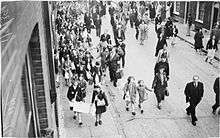
1 September 1939
- In response to the German invasion of Poland and the prospect of war with Germany, plans for the evacuation of children and nursing and expectant mothers from London and other areas deemed vulnerable to German air attack are put into action.
- The Blackout begins.
- The British Army is officially mobilized.
2 September 1939
- Under intense criticism from the House, Neville Chamberlain abandons an offer to negotiate peace terms between Germany and Poland and agrees to present an ultimatum to Hitler.
3 September 1939
- Shortly after 11:00 Chamberlain announces to the nation that his ultimatum has expired and that Britain is at war with Germany.
- Twenty minutes later the first air raid sirens are sounded in London. They are a false alarm.
- Chamberlain reforms his Government, creating a small War Cabinet which includes Winston Churchill as First Lord of the Admiralty.
- The National Service (Armed Forces) Act is passed. All men aged 18-41 are now potentially liable for conscription.
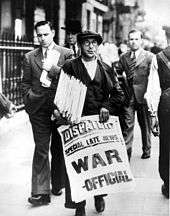
7 September 1939
- The National Registration Act is passed, introducing identity cards.
23 September 1939
27 September 1939
- The first war tax is revealed by the Cabinet, including a significant increase in income taxes.
1 October 1939
- Call-Up Proclamation: all men aged 20-21 who have not already done so must apply for registration with the military authorities.
6 October 1939
- With the end of formal Polish resistance the Phony War begins.
November 1939
- London schools start to reopen because of evacuee children returning to the capital.[4]
1940
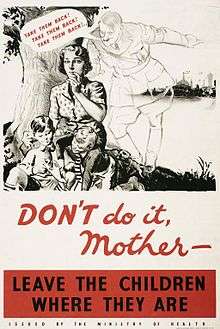
January 1940
- 35% of London schoolchildren had returned from evacuation.[4]
8 January 1940
- First food rationing introduced.
May to June 1940
- Further evacuation of 160,000 children from London and relocation of children who had been settled near vulnerable coastal areas.[4]
7 May 1940
- The debate on the recent debacle in Norway leads (on 10 May) to Chamberlain's resignation.
10 May 1940
- Germany invades France and the Low Countries, ending the Phony War.
- Winston Churchill becomes Prime Minister and forms an all-party coalition government.
12 May 1940
- Internment of all German or Austrian males aged between 16 and 60 begins, starting with those living nearest to the south and east coasts.[5]
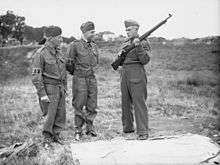
14 May 1940
- In a BBC radio broadcast Anthony Eden calls for the creation of the Local Defence Volunteers (LDV) militia - renamed on 23 July the Home Guard.
22 May 1940
- The Emergency Powers (Defence) Act 1940 is passed, granting the government even more authority to control persons and property for the duration of the war.
10 June 1940
- Italy declares war on Britain.
- Italian men aged 17 to 60 are arrested and interned.
- Large mobs attack Italian businesses and families in London, Liverpool, Belfast, Cardiff, Edinburgh and Glasgow.[6]
19 - 28 June 1940
- 25,000 Channel Island refugees arrive in England
30 June 1940
July 1940
- A further 60,000 schoolchildren evacuated from London and the Home Counties in the following 12 months.[4]
3 July 1940
- Cardiff is bombed for the first time.
6 July 1940
- Plymouth is bombed for the first time.
9 July 1940
- Official start date of the Battle of Britain.
10 July 1940
- Introduction of Defence Regulation 58AA allowing the Minister of Labour to ban strike action and force compulsory arbitration. No strikes are called by any trade union during the war; there are unofficial short local strikes in coal, shipbuilding and machinery.[7]
21 July 1940
- SS Anselm leaves Liverpool for Halifax, Nova Scotia with the first group of 82 children being evacuated under the Children's Overseas Reception Board (CORB) scheme.[8]
25 August 1940
- First major air raid on central Birmingham
28 August 1940
- First major air raid on Liverpool
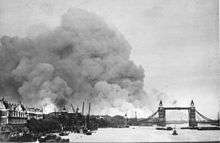
7 September 1940
- German bombing raid on South London; formal beginning of The Blitz.
18 September 1940
- SS City of Benares bound for Quebec is torpedoed and sunk in the Atlantic; 77 of the 90 evacuee children on board died, resulting in the abandonment of the CORB evacuation scheme.[9]
31 October 1940
- Official end date of the Battle of Britain.

14 November 1940
- Massive German bombing raid on Coventry.
24 November 1940
- First major air raid on Bristol
1941
21 January 1941
- The Communist Daily Worker is banned.
13 and 14 March 1941
- Major air raids destroy most of Clydebank

10 May 1941
- Last major attack on London of the 1940-41 Blitz.
1 June 1941
- Civilian clothing is rationed for the first time.[10]
18 December 1941
- The National Service (No. 2) Act is passed. All men and women aged 18-60 are now liable to some form of national service, including military service for those under 51. The first military registration of 18.5-year-olds takes place. The Schedule of Reserved Occupations is abandoned: from now on only individual deferments from the draft will be accepted.
1942
23 January 1942
- First US Army troops arrive in the UK. Disembarking at Belfast, the officers were the advanced party of a force intended to defend Northern Ireland and release British troops for service overseas.[11]
5 March 1942
- The Daily Mirror publishes a controversial cartoon by Philip Zec which Churchill and other senior government figures alleged was damaging to public morale. Zec is investigated by MI5 and the government seriously proposes banning the newspaper until parliamentary opposition forces a retreat.
23 April 1942
- Beginning of so-called Baedeker Blitz on English provincial towns, mainly chosen for their historic and cultural significance; Exeter, Bath, Canterbury, Lincoln and York along with several coastal towns were targeted. Attacks continue sporadically until 6 June.
1 July 1942
15 November 1942
- Church bells were rung all over the United Kingdom for the first time since May 1940, in celebration of victory at the Second Battle of El Alamein.[13]
1 December 1942
- Sir William Beveridge's Report on Social Insurance and Allied Services published.
The Ministry of Labour reports that 1942 strikes cost 1,527,000 working days, as compared with 1,079,000 in 1941.[14]
1943

18 February 1943
- The House of Commons votes, 335 to 119, against a Labour amendment demanding the creation of a Social Security Ministry and immediate implementation of the Beveridge report. The government has approved the plan "in principle" but called for a delay until the war is over.
19 February 1943:
- The Labour Party National Executive Committee rejects the Communist Party's application for affiliation saying it must carry out decisions of the Comintern in Moscow, that it has shown "complete irresponsibility in British politics" and because "its general outlook is entirely out of harmony with the philosophy and objectives of the Labour Party."[15]
7 April 1943
- The Government releases a White Paper by John Maynard Keynes, announcing its post-war currency stabilization plan designed to provide an international banking system.
12 April 1943
- The Chancellor of the Exchequer presents a budget of £5.8 billion with 56% to be raised from current revenue; the deficit would be £2.8 billion of which £2.2 will be borrowed at home.[16]
29 July 1943
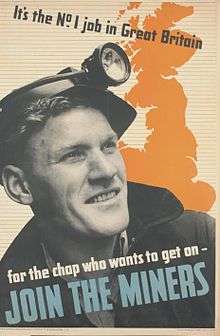
- Labour Minister Ernest Bevin announces that women from 19 to 50 will be called for work in plane and munitions plants. Men eligible for military service may choose work in coal mines.[17]
23 September 1943
- The Ministry of Health reports that 1942 births totaled 654,039 versus 480,137 in 1941; deaths 66,811 versus 55,043. Infant mortality was 49 per 1,000, the lowest on record for Britain.[18]
14 December 1943
- The first of first of 33 fortnightly ballot draws for the compulsory recruitment of men for coal mining, who would otherwise have been conscripted into the Armed Forces. These recruits would become known as "Bevin Boys".[19]
20 December 1943
- Villages in the South Hams area of Devon were compulsorily evacuated to create a training area for the planned D-Day landings. Also evacuated were the villages of Imber in Wiltshire and Tyneham in Dorset. The inhabitants of the last two have never been allowed to return.
1944
21 January 1944
- Start of Operation Steinbock or the "Baby Blitz", a Luftwaffe night bombing campaign against southern England, which continued until May 1944.
10 March 1944
- R.A. Butler's Education Act passed, reorganizing Britain's school system under the tripartite system.
12 June 1944
- First V-1 flying bomb attack on London.

July to September 1944
- Final wave of evacuation (codenamed "Rivulet") of children from London to the English Midlands and West Country.[4]
8 September 1944
- First V-2 rocket attack on London.
17 September 1944
- The Blackout is replaced by a partial 'dim-out'.
22 September 1944
- Ernest Bevin announces the government's plan for eventual military demobilization.
3 December 1944
- The Home Guard is stood down.
1945
1 February 1945
- Part-time members of the National Fire Service are stood down.[20]
27 March 1945
- Last V-2 attack on London.
29 March 1945
- Last V-1 flying bomb attack on London.
2 May 1945
- Civil Defence Service is stood down.[20]

8 May 1945
9 May 1945
23 May 1945
- The Labour Party members of the coalition government resign in order to prepare for the upcoming general election. Churchill appoints a largely Conservative caretaker government.
16 June 1945
- The Family Allowances Act passed. Mothers will receive a tax-free cash payment for each child in their care. This is the first time in Britain that a state payment has gone directly to a wife rather than her husband.
18 June 1945
- Demobilisation of the armed forces begins.

5 July 1945
- General election voting takes place in the UK. The ballots are then sealed for three weeks to allow the collection and counting of overseas service votes.
26 July 1945
- The Labour Party wins the general election with a historic landslide. Clement Attlee becomes Prime Minister and forms a new government.
15 August 1945
See also
Notes and references
- ↑ The main sources are Facts on file yearbook (compilation of weekly reports) and Keesing's Contemporary Archives (monthly reports), both online.
- ↑ Perry, Frederick W., 1988, The Commonwealth Armies: Manpower and Organisation in Two World Wars Manchester University Press ISBN 0-7190-2595-8 (p. 50)
- ↑ Freeman, Joseph Bray (1945), Commodity Control Butterworth (p. 146)
- 1 2 3 4 5 "Information Leaflet Number 32 - The evacuation of children from the County of London during the Second World War" (PDF). http://www.cityoflondon.gov.uk/. London Metropolitan Archives. November 1997. External link in
|website=(help) - ↑ Cesarani, David and Kushner, Tony (1993), The Internment of Aliens in Twentieth Century Britain Routledge, ISBN 0-7146-3466-2 (p. 149)
- ↑ Cesarani and Kushner (pp. 172-173)
- ↑ Dropkin, Greg (29 May 2003). "Strikes during wartime". www.labournet.net. Retrieved 13 March 2015.
- ↑ Fethney, Michael (1990), The Absurd and the Brave: C.O.R.B. - The True Account of the Government's World War II Evacuation of Children Overseas, Book Guild Publishing Ltd ISBN 9780863324475 (p. 60)
- ↑ Fethney p. 148
- ↑ Ross, Stewart (2007), Rationing (At Home in World War II), Evans Brothers Ltd ISBN 978-0237533953 (p. 113)
- ↑ "American Forces in Northern Ireland". www.secondworldwarni.org. Retrieved 20 February 2015.
- ↑ Briggs, Susan (1975), The Home Front: War Years in Britain, 1939-1945, American Heritage Publishing Co (p. 112)
- ↑ Taylor, A J P (1965), English History 1914-1945, Oxford University Press, ISBN 0-19-280140-6 (p. 560)
- ↑ Facts on File, Facts on file yearbook 1943 (1944) p. 178
- ↑ Facts on File, Facts on file yearbook 1943 (1944) p. 59
- ↑ Facts on File, Facts on file yearbook 1943 (1944) p. 115
- ↑ Facts on File, Facts on file yearbook 1943 (1944) p. 243
- ↑ Facts on File, Facts on file yearbook 1943 (1944) p. 307
- ↑ Taylor, Warwick H. "Bevin Boys Association" (PDF). http://www.seniorsnetwork.co.uk/bevinboys/index.htm. Retrieved 15 February 2015. External link in
|website=(help) - 1 2 Essex-Lopresti, Tim; Woolven, Robin (2005). "A Brief History of Civil Defence" (PDF). www.civildefenceassociation.org.uk. Civil Defence Association. Retrieved 6 February 2015.
Further reading
- Addison, Paul. "The Impact of the Second World War," in Paul Addison and Harriet Jones, eds. A Companion to Contemporary Britain: 1939-2000 (2005) pp 3–22
- Brivati, Brian, and Harriet Jones, ed. What Difference Did the War Make? The Impact of the Second World War on British Institutions and Culture. Leicester UP; 1993.
- Calder, Angus . The People's War: Britain 1939-45 (1969), highly influential survey
- Corelli, Barnett. The Audit of War: The Illusion and Reality of Britain as a Great Nation. (1986)
- Costello, John. Love, Sex, and War: Changing Values, 1939-1945 (1985)
- Fielding, S., P.Thompson and N. Tiratsoo, 'England Arise!': The Labour Party and Popular Politics in 1940s Britain (Manchester UP, 1995),
- Fox, Jo. Film propaganda in Britain and Nazi Germany: World War II cinema (2007)
- Gartner, Niko. Operation Pied Piper: the wartime evacuation of schoolchildren from London and Berlin 1938–46 (2012)
- Hancock, W. K. and Gowing, M.M. British War Economy (1949) (official History of the Second World War). London: HMSO and Longmans, Green & Co. Available on line at: British War Economy.
- Hancock, W. K. Statistical Digest of the War (1951) (official History of the Second World War). London: HMSO and Longmans, Green & Co. Available on line at: Statistical Digest of the War.
- Harris, Carol. Women at War 1939-1945: The Home Front. (2000) Thrupp: Sutton Publishing Limited. ISBN 0-7509-2536-1.
- Hayes, Nick, and Jeff Hill. 'Millions like us'?: British culture in the Second World War (1999)
- Hubble, Nick. Mass-Observation and Everyday Life (Palgrave Macmillan. 2006). ISBN 1-4039-3555-6.
- Jones, Helen (2006). British civilians in the front line: air raids, productivity and wartime culture, 1939-45. Manchester University Press. ISBN 978-0-7190-7290-1.
- Lant, Antonia Caroline. Blackout: Reinventing women for wartime British cinema (Princeton University Press, 2014(
- Maartens, Brendan. "To Encourage, Inspire and Guide: National service, the people’s war and the promotion of civil defence in interwar Britain, 1938–1939." Media History 21#3 (2015): 328-341.
- Marwick, Arthur. The Home Front: The British and the Second World War. (1976)
- Moshenska, Gabriel. "Spaces for Children: School Gas Chambers and Air Raid Shelters in Second World War Britain." in Reanimating Industrial Spaces: Conducting Memory Work in Post-industrial Societies 66 (2014): 125+.
- Nicholas, Siân. The Echo of War: Home Front Propaganda and the Wartime BBC, 1939-1945 (Palgrave Macmillan, 1996)
- Postan, Michael British War Production (1952) (official History of the Second World War). London: HMSO and Longmans, Green & Co. Available on line at: British War Production.
- Roodhouse, Mark. Black Market Britain, 1939–1955 (Oxford UP, 2013)
- Rose, Sonya O. Which People's War?: National Identity and Citizenship in Wartime Britain 1939-1945 (2003)
- Short, Brian. The Battle of the Fields: Rural Community and Authority in Britain during the Second World War (2014)
- Smart, Nick. British strategy and politics during the phony war: before the balloon went up (Greenwood, 2003)
- Titmuss, Richard M. (1950) Problems of Social Policy. (official History of the Second World War). London: HMSO and Longmans, Green & Co. Available on line at: Problems of Social Policy official history
- Woodward, Guy. Culture, Northern Ireland, and the Second World War (Oxford UP, 2015)
Historiography
- Harris, Jose. "War and social history: Britain and the home front during the Second World War," Contemporary European History (1992) 1#1 pp 17–35.
